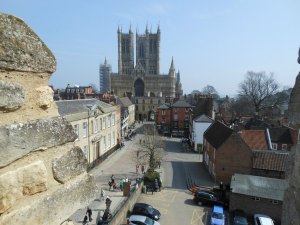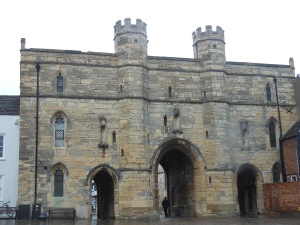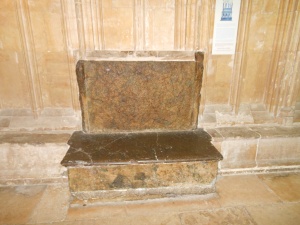While researching Lincoln this week I came across the unhappy story of Little St Hugh, a young boy whose death caused a lethal backlash of blame and recrimination which attracted the attention of the king, Henry III, himself.
The story revolves around a young boy called Hugh. Born around 1246 he was probably 9 years old when he disappeared on 31st July 1255. No one seems to know who Hugh’s father was, or even if he had one – some sources suggest he was illegitimate – but his mother was a Lincoln lady called Beatrice.
According to reports young Hugh had been doing what all boys do at that age – he’d been out playing with friends. But when it got late the lad could not be found. His mother spent days looking for him and apparently was eventually told by some neighbours that he had last been seen ‘playing with some Jewish boys of his own age, and going into the house of a Jew.’¹
According to Matthew Paris it was Beatrice, herself, who had discovered Hugh’s body sometime around 27th August 1255, after marching into the house Hugh had been seen going into. Little Hugh’s body was supposedly found in a well at the property of a Lincoln Jew, named Copin (or Jopin, Joscefin or Koppin).
Poor Copin was immediately seized by those present when the body was found; Beatrice and her neighbours and the city’s bailiffs all appear to have been in attendance. In no time at all a dreadful tale of ritual murder and the ‘blood libel’ (where it was believed Christian children were tortured and killed in Jewish rituals, supposedly mimicking the crucifixion of Christ) was woven around the tragedy of the little boy’s death.
According to Paris:
… having shut him up in a room quite out of the way, where they fed him on milk and other childish nourishment, they sent to almost all the cities of England where the Jews lived, and summoned some of their sect from each city to be present at a sacrifice to take place at Lincoln; for they had, as they stated, a boy hidden for the purpose of being crucified. In accordance with the summons, a great many of them came to Lincoln, and on assembling, they at once appointed a Jew of Lincoln as judge to take the place of Pilate, by whose sentence, and with the concurrence of all, the boy was subjected to divers tortures They beat him till blood flowed and he was quite livid, they crowned him with thorns, derided him and spat upon him. Moreover, he was pierced by each of them with a wood knife, was made to drink gall, was overwhelmed with approaches and blasphemies, and was repeatedly called Jesus the false prophet by his tormentors, who surrounded him, grinding and gnashing their teeth. After tormenting him in divers ways, they crucified him, and pierced him to the heart with a lance.²
It is still unclear whether or not Little Hugh was murdered; some sources suggest that it could have been a terrible accident or the boy lost his footing and fell down the well (although the well in question was apparently only dug in 1910)3. And even if the boy was murdered, it is far from clear that Copin was the culprit. However, one man took the initiative and played on the prejudices of the time to, not only, create a scapegoat but use the anti-Semitism prevalent at the time in order to blame the Jewish population of England as a whole.
John of Lexington was one of the witnesses at the discovery of the body and appears to have been the one to investigate the accusation of ritual murder levelled at Copin, probably by the distraught Beatrice. He may have been familiar with the case, just over a century earlier, of William of Norwich, who died in 1144 and whose death was said to involve a mock execution at the hands of a converted Jew named Theobald.
Lexington, described as ‘a man of learning, prudent and discreet‘² by Matthew Paris, managed to persuade Copin to confess and describe the murder in return for a promise of protection from torture and execution. Copin is said to have confessed to his involvement, and described the scourging, disembowelling, crowning with thorns and crucifixion of the young boy. He went on, it seems, to implicate the rest of his people, saying ‘nearly all the Jews of England agreed to the death of this boy.’4
At the time of the death many prominent Jewish families had congregated in Lincoln; not to commit murder, but to celebrate the marriage of Bellaset, the daughter of Berechiah de Nicole. These were suddenly caught up in the tragedy and more than 90 of them were arrested and charged with practicing ritual murder. They were sent to London and imprisoned in the Tower to await trial.
In the mean time rumours of miracles started circulating and being attributed to Little Hugh. It was said his body had been thrown down the well because when Copin had tried to bury him the earth had thrown the corpse back out. In another miracle attributed to him a blind woman regained her sight by bathing her eyes in water from the well in which Hugh’s remains had been found. Having heard of the miracles associated with Little Hugh, the canons of Lincoln Cathedral requested the body and Little Hugh ‘was honourably buried in the church of Lincoln as if it had been the corpse of a precious martyr,’² with the Cathedral even raising a shrine to the memory of Little Saint Hugh.
As for Copin; the story of a boy’s murder by England’s Jews had attracted the attention of England’s king, Henry III. According to Paris the king himself reproached John of Lexington for having promised life to such a ‘wicked being’ and the poor man was condemned to death. He was tied to the tail of a horse and dragged through the streets to the gallows, and hung.
Just 6 months before Hugh’s death the king had sold his rights to tax the Jews to his younger brother Richard, earl of Cornwall. However, he retained the right to receive the goods and property of any Jew implicated in a crime. This made the 90 Jews arrested alongside Copin extremely valuable to the king if they were guilty – and to his brother if they were innocent. Of these 90 or so Jews caught up in the aftermath of the tragedy, 18 ‘of the richer and higher order of Jews of the city of Lincoln’² were condemned to death and dragged to gibbets erected especially and hung; their property confiscated by the king.
The remaining prisoners were eventually released, following payment of their ransom by the Earl of Cornwall; his personal Jew had probably been caught up in the arrests and so it was in Cornwall’s interests to get the Jews released. Among those freed was Berechiah de Nicole, the father of the bride for whose wedding the Jews had been gathered in Lincoln.
The tragedy of Little Hugh’s death was only worsened by the judicial murders of so many innocent Jews in revenge. Little St Hugh is the best known of the ‘blood libel’ saints and although a shrine was erected in Lincoln Cathedral, with a feast day of 27th August, Little Hugh was never canonised by the Vatican and has never been included in the official roll of Catholic martyrs. The shrine inside the cathedral, although still there, has lost its canopy and now has a sign at the side, explaining the legend and telling the sad tale of the boy’s death and its dreadful aftermath.
Little Hugh’s story would continue to be told in the succeeding centuries. It has been the subject of ballads in both English, Scottish and French poetry and is referred to by Chaucer in The Prioress’s Tale and by Marlowe in the Jew of Malta.
*
Footnotes:
¹Matthew Paris, quoted by Haidee J Lorrey from oxforddnb.com; ²Matthew Paris, Of the cruel treatment of the Jews for having crucified a boy from arts.cornell.edu; ³It’s About Lincolnshire via Twitter; 4Matthew Paris, quoted by Haidee J Lorrey from oxforddnb.com.
And thanks to Dean Irwin for clarifying some points for me.
*
Article and photos of Lincoln Cathedral and precincts ©2015 Sharon Bennett Connolly; Picture of the Body of Little Hugh courtesy of Wikipedia.
Sources:
arts.cornell.edu; oxforddnb.com; pillingswritingcorner.blogspot.co.uk; britannica.com; Who’s Buried Where in England by Douglas Greenwood; Chronicles of the Age of Chivalry Edited by Elizabeth Hallam; The Plantagenets, the Kings that made Britain by Derek Wilson; England Under the Norman and Angevin Kings 1075-1225 by Robert Bartlett; jewishencyclopedia.com.
*
My books
Signed, dedicated copies of all my books are available, please get in touch by completing the contact me form.
Defenders of the Norman Crown: The Rise and Fall of the Warenne Earls of Surrey tells the fascinating story of the Warenne dynasty, of the successes and failures of one of the most powerful families in England, from its origins in Normandy, through the Conquest, Magna Carta, the wars and marriages that led to its ultimate demise in the reign of Edward III. Defenders of the Norman Crown: Rise and Fall of the Warenne Earls of Surrey is now available from Pen & Sword Books, Amazon in the UK and US, Bookshop.org and Book Depository.
1 family. 8 earls. 300 years of English history!
Also by Sharon Bennett Connolly:
Ladies of Magna Carta: Women of Influence in Thirteenth Century England looks into the relationships of the various noble families of the 13th century, and how they were affected by the Barons’ Wars, Magna Carta and its aftermath; the bonds that were formed and those that were broken. It is now available in paperback and hardback from Pen & Sword, Amazon, Bookshop.org and from Book Depository worldwide.
Heroines of the Medieval World tells the stories of some of the most remarkable women from Medieval history, from Eleanor of Aquitaine to Julian of Norwich. Available now from Amberley Publishing and Amazon, Bookshop.org and Book Depository.
Silk and the Sword: The Women of the Norman Conquest traces the fortunes of the women who had a significant role to play in the momentous events of 1066. Available now from Amazon, Amberley Publishing, Bookshop.org and Book Depository.
*
You can be the first to read new articles by clicking the ‘Follow’ button, liking our Facebook page or joining me on Twitter and Instagram.
©2016 Sharon Bennett Connolly







Reblogged this on Rifleman III Journal.
LikeLiked by 1 person
Thank you 🙂
LikeLike
You’re welcome.
LikeLike
Quite an eyeopener…I always liked the way Ivanhoe fights to save the life of Rebecca in the classic novel set in that time period…Justice for all with the warrior hero winning the day…However this story is probably closer in truth and it chills the blood…
LikeLiked by 1 person
I quite agree – it always amazes me how cruel people can be to each other. And how their fears and prejudices can do easily rise to the surface and cause such pain. It’s such a sad story.
LikeLike
This is a very sad story, but so demonstrative of the attitudes of the times. I find it ironic that the Jews of the diaspora were treated so much better in Arabic countries than they were in Europe.
LikeLike
Absolutely, Susan. It’s a sad reflection on European attitudes to other races throughout history.
LikeLike
I suppose this was part of what led to the expulsion of the Jews in 1290?
LikeLike
I don’t think so. The Jews had been blamed when things went wrong for centuries – there was a dreadful incident in York during the reign of Richard I, where the Jews had sought refuge in Clifford’s Tower and chose to kill themselves rather than face the mob. The final expulsion was probably more financially motivated – Edward I expelling the Jews so he could appropriate their property in order to pay for his costly wars.
LikeLike
I remember reading about Hugh and William in a book called Lives of the Saints when I was a child. And the Jews were wholeheartedly blamed for the children’s deaths. If I remember correctly, the book was printed in the 1950’s. Though, surely, those children became apocryphal saints at the same time Christopher was taken off the list in the 1960’s?
LikeLike
I think so, Maria. Although Hugh existed, his position as a saint seems to have been quite dodgy.
LikeLiked by 1 person
Reblogged this on writerchristophfischer and commented:
One of the great history blogs I follow with a particularly interesting, albeit tragic, story
LikeLike
Thank you christoph, I’m honoured.
LikeLiked by 1 person
You’re welcome 😊
LikeLike
Reblogged this on and commented:
Mureder or Accident? The sad tale of little Hugh of Lincoln were the Jewish community guilty or scapegoats for prejudice. Fascinating reading from History The Interesting Bits
LikeLike
Reblogged Sharon. A sad indictment of possible scapegoating the Jewish Community . If it was an accident and he had fallen down the Well it makes the execution of some of the Jewish Community hideously wrong. What is done supposedly in the name of organised religion never ceases to distress. Great blog. Thank you
LikeLike
Thank you Karrie. It’s a sad story, but one we shouldn’t ever forget.
LikeLike
Very interesting, Sharon. It gives a lot of background to a blog I wrote some time ago, which may be of interest if you haven’t seen it. In a way (I hope) it complements this story by covering the story in the context of later folk songs. Here is a link. Best wishes,
Charles Bazalgette.
LikeLike
Thank you Charles. Great article. Very interesting, thank you. Best wishes, Sharon
LikeLiked by 1 person
Thank you 🙂
LikeLike
Have just returned from a fascinating 3 days in Lincoln and, of course, spent considerable time in the Cathedral. Re “Little St. Hugh”, I read that when his tomb was opened, it was discovered that no mutilation etc. was ever found on his remains, dispelling all the rumours of these sad stories of the rites of Jews on children.
LikeLike
That’s right. There was no basis for them, just fearmongering and looking for scapegoats. Such a sad affair in England’s history. I hope you enjoyed Lincoln, Gill? It’s such a fabulous city. 🙂
LikeLike
Very sad – I went to a prep school near Lincoln called St Hughs (Woodhall Spa) – it’s still there. The school badge was a ball going over a wall and the story we were taught was that he went into the garden to get back his ball that had gone over the garden wall while playing – never to be seen again
LikeLiked by 1 person
That’s interesting Keiron, thank you. It’s nice to think that poor little Hugh is remembered in a school name – a greater legacy than the witch hunt which followed his death.
LikeLike
Great post. I know about ithavi got listened to and read the ballad and its historical background. Steeleye Span does a good version of it.
LikeLike
Thank you Emily.
LikeLike